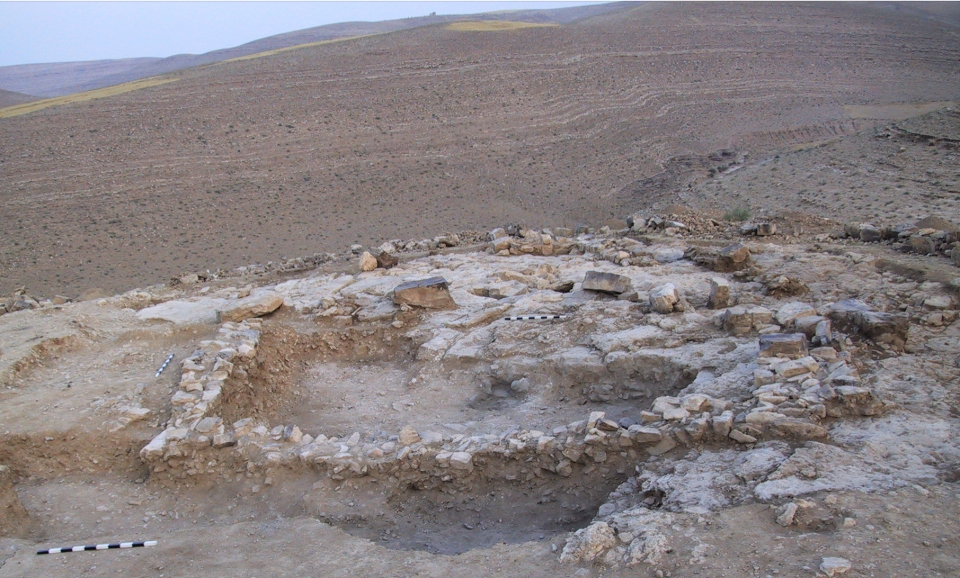Some kilometres west of Khirbat al-Mudayna a cultic site was discovered on top of a natural hill: Wadi ath-Thamad Survey Site WT-13. Salvage excavations were conducted in 1997-1999, 2001, and 2003. Although the site was heavily disturbed, a square building with benches alongside the walls could be excavated. The investigations produced dozens of figurines, fragments of anthropomorphic statues, and a large amount of pottery.
Two principal use phases of the site were uncovered, both related to ritual activity. The earlier phase, found only in the 2003 season, consists of an area located at a point where the bedrock drops almost 1.00 m to form a natural wind break. In this protected area, four cooking areas were situated up against the bedrock scarp. Associated with these ovens were thousands of animal bones, ash, and large amounts of broken pottery. Missing from this assemblage are the figurines and statues that are characteristic of the later use phase.
This area of food preparation was covered over at some point and a new cultic area was designed. A temenos wall was built above the soil layers sealing the earlier material and extending to the west, where it was footed on the bedrock. It is in the soil layers and crevices in the bedrock, associated with this enclosed space, that the important corpus of pottery and artefacts was first uncovered (1996–2001 seasons). Finds from this second use phase include 30+ intact and broken figurines, 17 anthropomorphic clay statues, and a group of ceramic fragments that consist of faces, noses, ears, pieces of hairdo, arms, and legs (see Daviau 2001).
The anthropomorphic figures represent both women and men and appear to be votive offerings made at the shine to protective deities. In the case of the tall ceramic statues, these figures are shown carrying loaves of bread in their hands, bearing a lamp on their heads, or simply with their hands flat against their body. The smaller figurines are of two types, free-standing (where the lower body is depicted) and pillar figurines (with a conical lower body or skirt). In some cases, the free-standing figurines depict a female carrying a disc held against her chest, whereas pillar figurines are shown with a circular drum held perpendicular to the waist. The remaining figurines in ceramic and in stone are each unique.
For the most part, the figurines do not reflect the worship of Asherah represented by the pillar figurines with prominent breasts found in considerable number in the Jerusalem area. Instead, the majority of figurines at WT-13 are votive figures, representing worshippers, rather than a deity, or are representations of musicians playing frame drums. These small figurines indicate clearly that music, and possibly dancing, was part of the local ritual. This can be compared with both Phoenician and Israelite religious practice.
The closest parallels for the ceramic statues are those from Borvat QiTmiT and ‘En BaSeva, two sites in the Negev of Israel that have been identified with Edomite culture. Three statues from WT-13 retain evidence of painted lines and bands visible on the torso that may represent clothing. Because of the great variation in size, features and ceramic fabric, fragments of the statues from WT-13 were subjected to INAA analysis at the Institute of Nuclear Techniques, Budapest University of Technology and Economics, as part of the research project of Jan Gunneweg, Hebrew University of Jerusalem, who also analysed the fabric of statues from the Negev sites. His report, submitted in June 2004, will be included in the final publication of Site WT-13. To date, the analysis indicates that 10 out of 11 samples consist of local Transjordanian clay sources, while one sample comes from the southern kingdom of Edom; none come from sources known in Cisjordan.
The ceramic vessel fragments, especially the diagnostic sherds, from the Shrine Site are being studied and compared with the temple pottery from Khirbat al-Mudayna. at the Pottery Institute of the University of Leiden. The research team includes Drs. Margreet Steiner, Abraham van As, and Mr. Lou Jacobs. The chapters on the pottery will appear in the monograph on Site WT-13 (Daviau, in preparation) and in the volume on the North Gate and Temple 149 (Chadwick, Steiner and Daviau, in preparation).
Also of interest are the fragments of ceramic architectural models which represent shrines. Various styles have been identified and can be compared to models from Tall al-‘Umayri in Ammon, the Madaba area, Pella in the Jordan Valley, Lebanon, and their origins in the Syrian tradition (Daviau 2007). These artefacts were recovered in both temple and domestic contexts, evidence of complex ritual traditions.
Main publications
Daviau, P. M. M., 2014 The Coroplastics of Transjordan: Forming Techniques and Iconographic Traditions in the Iron Age. Pp. 1-11 in ‘Figuring Out’ the Figurines of the Ancient Near East, ed. S. Langin-Hooper. Occasional Papers in Coroplastic Studies 1, online. USA: Association for Coroplastic Studies.
Daviau, P. M. M., 2012 Diversity in the Cultic Setting: Temples and Shrines in Central Jordan. Temple Building and Temple Cult: An International Conference on the Architecture and Cultic Paraphernalia of Temples in the Levant (2.-1. Mill. B.C.E.), ed. J. Kamlah. Abhandlungen des Deutschen-Palästina-Vereins 41. Wiesbaden: Harrassowitz Verlag.
Daviau, P. M. M., 2008 Ceramic Architectural Models from Transjordan and the Syrian Tradition. Pp. 293–308 in Proceedings of the 4th International Congress of the Archaeology of the Ancient Near East. Berlin, Germany (29 March–3 April 2004), I: The Reconstruction of Environment: Natural Resources and Human Interrelations through Time, Art History: Visual Communication, eds. J. Kühne, R. M. Czichon, and F. J. Kreppner. Wiesbaden: Harrasowitz Verlag.
Daviau, P. M. M., 2007 Altars Large and Small. The Iron Age Altars from Virbet el-Mudeyine (Jordan). Pp. 125‒149, Pl. XXI in Bilder als Quellen/Images as Sources. Studies on Ancient Near Eastern artefacts and the Bible inspired by the work of Othmar Keel, eds. S. Bickel, S. Schroer, R. Schurte and C. Uehlinger. Orbis Biblicus et Orientalis, Special volume. Fribourg: Academic Press/Göttingen: Vandenhoeck & Ruprecht.

